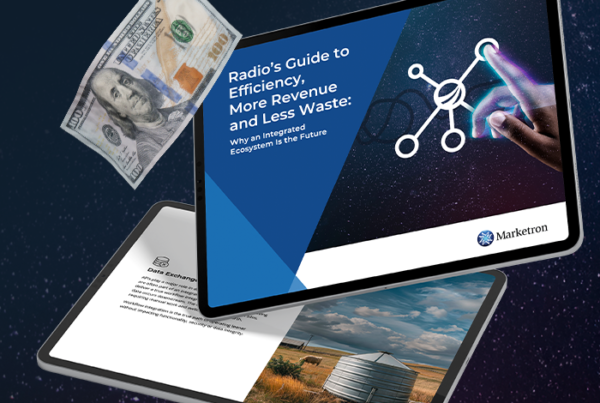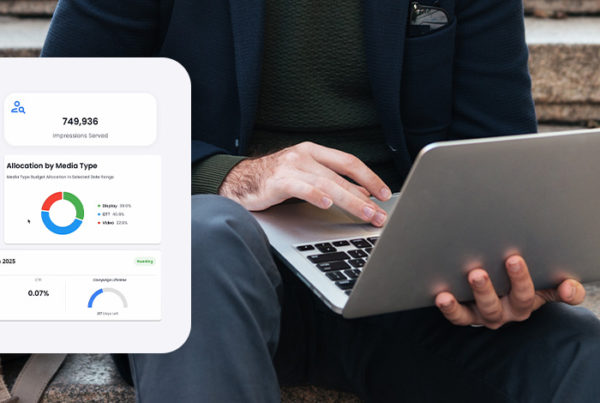As a local media company, your organization can meet all the advertising needs of businesses. You can build an integrated campaign by providing digital and radio advertising recommendations. With this mix of tactics, advertisers get the breadth of reach from radio and the targeting capabilities of digital.
Digital advertising makes radio stronger, amplifying ad spend returns for your customers and growing your revenue. No matter the budget or goals of the advertiser, you have the products, experience and expertise to deliver a campaign that takes advantage of the opportunities of digital plus radio.
How Do Media Companies Effectively Sell Digital and Radio Advertising Together?
Traditional ad sales lived in silos, with linear in one bucket and digital in another. Businesses and sellers had mindsets that these tactics needed to be separate. However, that’s not what the data tells us about how the two work together. Significant evidence verifies that radio ads lift digital ad tactics. It has something to do with the “mere exposure effect,” which suggests that the more someone hears or sees something they’re neutral to, the more likely they are to think positively about it.
The Radio Advertising Bureau examined the pairing of radio and digital, finding that an ad spot on the radio generates more Google search activity. Similar studies identified that radio lifts Facebook advertising.
You may have your own case studies that validate these points, so selling this idea can start with data that illustrates the power of digital and radio advertising as a team. The next step is to ensure that your customers know you can offer them both and for them to see a detailed campaign proposal that includes digital and linear.
Finally, you should discuss how radio and digital will help them achieve their advertising goals. This is the foundation for the ad content, choosing programming and dayparts, and defining targeting.
What’s the Right Mix of Radio and Digital?
There is no magic formula. It depends on the budget, objectives and audience a company wants to reach. You start with the goal and build the proposal from there. Here’s an example. A local grocery store wants to promote online shopping and pickup to adults 30 and older who are parents, have a household income of over $150,000 and have full-time jobs. They have a budget of $15,000.
You have the information to design a proposal. You’ll start with the duration of the campaign, at 90 days. You could then recommend this breakout of tactics:
- Radio spot ads in the early morning and rush hour dayparts, as the audience would most likely be listening at these times
- OTT/CTV ads that target the demographics and characteristics of the target audience
- Geofencing static and video ads with fences around competitors and where busy parents spend time (e.g., parks, family-friendly areas)
- Facebook ads with special promos for first-time orders targeted to the persona
In this mix, you have a balance of digital and radio. Notice that digital has three different tactics, which is a best practice to follow.
Ideally, you’ll be able to present this to the business in one proposal, which outlines all the details of the on-air spots, targeting and geofenced areas.
Combining Digital and Radio: It’s a Sales Mindset Supported by Technology
The sales mindset of integrating digital and radio advertising has several pillars. First, you should always discuss both with customers regardless of if they’ve only purchased one or the other from you. The message to them is that you’ve got them covered for both.
Second, sellers must be strategic about tactics to suggest, which means they need to have considerable knowledge about them and how they work. This is often a weakness in media companies, but sellers’ acumen can grow with regular training and access to resources.
Third, it has to be easy. Salespeople don’t want to use multiple systems, re-enter data or spend hours combining proposals. They need technology that does the work for them as they fill in the details of targeting, tactics, programming and budget. Without this vital piece, having a digital-plus-radio mindset is hard. The platform to make this a reality is a digital ad solution built for media companies that integrates digital and radio into one proposal and order.
It should integrate with your traffic system and other applications and should be the single source for proposing, ordering, reporting and billing. When you have this, there’s no reason for sellers to sell only radio or digital.
The Future of Local Media Sales Is Radio + Digital
The future of winning ad dollars in the local market depends on ensuring that this mindset permeates your sales team and that they have the technology to support it. For your organization’s revenue to grow, selling omnichannel campaigns is the path to prosperity.
Marketron NXT is the solution to guide you through this future. It has everything you need without being overly complex or expensive. It’s intuitive and designed for your workflows and requirements. Take a tour of its features and all the services that come with it — training, digital expert guidance and more.






